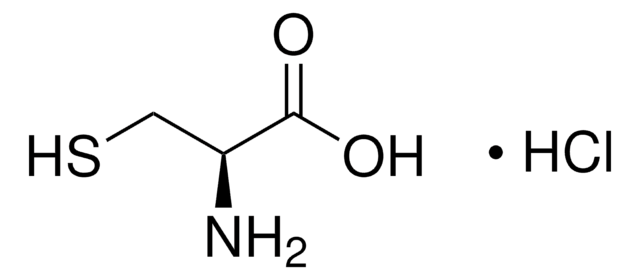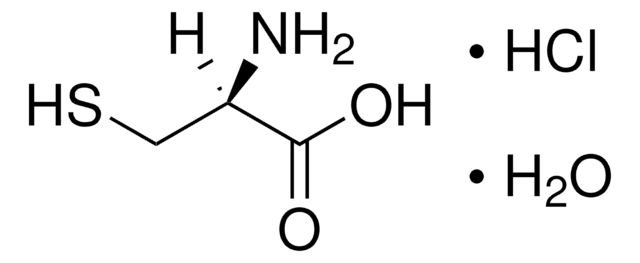C7880
L-Cysteine hydrochloride monohydrate
≥98% (TLC)
Synonym(s):
L-Cysteine hydrochloride hydrate (1:1:1)
About This Item
Recommended Products
Product Name
L-Cysteine hydrochloride monohydrate, reagent grade, ≥98% (TLC)
grade
reagent grade
Quality Level
Assay
≥98% (TLC)
form
powder
color
white
application(s)
cell analysis
peptide synthesis
SMILES string
O.Cl.N[C@@H](CS)C(O)=O
InChI
1S/C3H7NO2S.ClH.H2O/c4-2(1-7)3(5)6;;/h2,7H,1,4H2,(H,5,6);1H;1H2/t2-;;/m0../s1
InChI key
QIJRTFXNRTXDIP-JIZZDEOASA-N
Looking for similar products? Visit Product Comparison Guide
General description
Application
Biochem/physiol Actions
Storage Class Code
11 - Combustible Solids
WGK
WGK 1
Flash Point(F)
Not applicable
Flash Point(C)
Not applicable
Personal Protective Equipment
Choose from one of the most recent versions:
Already Own This Product?
Find documentation for the products that you have recently purchased in the Document Library.
Customers Also Viewed
Articles
This procedure applies to all products that have a specification for Cathepsin B activity determined by the liberation of 7-amino-4-methylcoumarin from Z-Arg-Arg 7-amido-4-methylcoumarin.
Antioxidants protect biological systems from oxidative damage produced by oxygen-containing free radicals and from redoxactive transition metal ions such as iron, copper, and cadmium.
Protocols
This procedure may be used for all Phosphoglucomutase products except for Phosphoglucomutase, Catalog Number P4109.
This procedure may be used for all Ficin products.
This procedure may be used for all Ficin products.
Our team of scientists has experience in all areas of research including Life Science, Material Science, Chemical Synthesis, Chromatography, Analytical and many others.
Contact Technical Service



